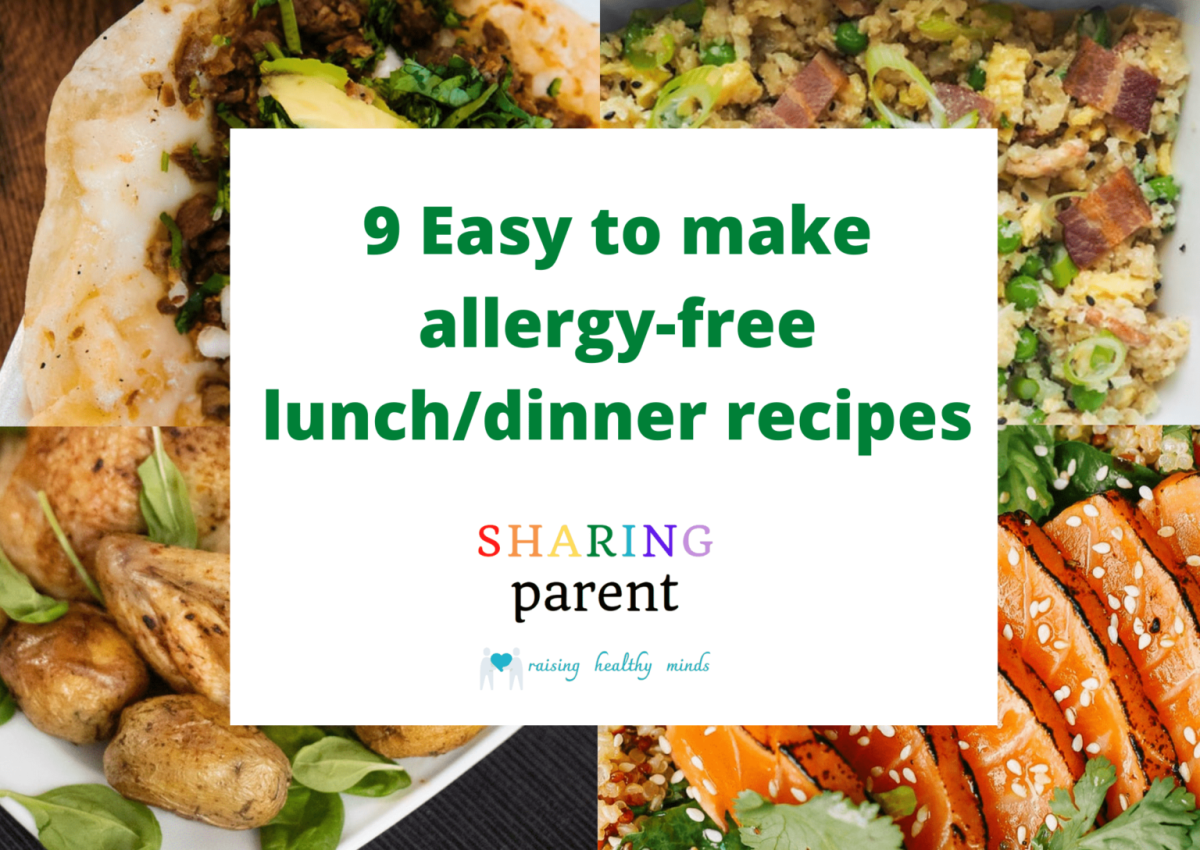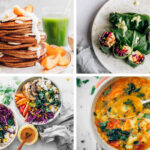Juggling work, kids, and healthy eating? Allergen-free cooking doesn’t have to be a culinary marathon. This guide unveils a treasure trove of quick and easy allergen-free dinner recipes designed for busy families. We’ll equip you with essential pantry staples, time-saving techniques, and adaptable meal planning strategies to navigate the world of allergy-friendly cuisine without sacrificing flavor or precious time. Imagine stress-free evenings filled with delicious, healthy meals that the whole family can enjoy, regardless of dietary restrictions.
From simple weeknight dinners to clever adaptations of family favorites, we’ll show you how to effortlessly create satisfying meals that are both allergy-conscious and incredibly delicious. Learn to streamline your cooking process, reduce food waste, and confidently tackle the challenges of allergen-free meal preparation. Discover the joy of effortless, healthy eating for the entire family.
Essential Allergen-Free Pantry Staples for Quick Meals
Stocking your pantry with the right allergen-free staples is key to creating quick and delicious dinners, even on the busiest weeknights. These essential ingredients offer versatility, allowing you to whip up a variety of meals with minimal effort and maximum flavor, while keeping your family safe and satisfied. Proper storage is crucial not only to maintain freshness but also to prevent cross-contamination, ensuring the safety and integrity of your allergen-free meals.
Five Essential Allergen-Free Pantry Staples and Their Uses
A well-stocked allergen-free pantry hinges on a few key ingredients. These versatile staples form the foundation for countless quick and easy meals, minimizing food waste and maximizing efficiency in the kitchen. Careful storage practices will ensure these ingredients remain fresh and safe for consumption.
- Gluten-Free Pasta: Choose a variety you enjoy, such as brown rice pasta, quinoa pasta, or lentil pasta. Its versatility shines through in quick pasta dishes. Think simple tomato sauce with vegetables, pesto with cherry tomatoes, or a creamy coconut milk-based sauce with spinach and chickpeas. Store in an airtight container in a cool, dry place. To prevent cross-contamination, ensure your utensils and surfaces are thoroughly cleaned before and after use.
- Canned Beans (Black Beans, Chickpeas, Kidney Beans): A powerhouse of protein and fiber, canned beans are incredibly convenient. Rinse and drain them before use to remove excess sodium. They’re fantastic additions to salads, soups, stews, and can even be mashed into a quick dip. Store unopened cans in a cool, dark pantry; once opened, transfer beans to an airtight container in the refrigerator for up to 5 days. Always ensure you are using clean utensils to avoid cross-contamination.
- Canned Tomatoes (Diced, Crushed, or Whole): The foundation of countless sauces and soups, canned tomatoes are a staple. Use them to create quick pasta sauces, add them to stews, or blend them into a simple soup. Store unopened cans in a cool, dark pantry; once opened, transfer to an airtight container in the refrigerator for up to a week. Again, meticulous cleanliness of utensils and surfaces is key.
- Rice (Brown Rice, White Rice): A quick-cooking grain that provides a base for many meals. Brown rice is more nutritious, but white rice cooks faster. Use it as a side dish, incorporate it into stir-fries, or use it as a base for bowls. Store rice in an airtight container in a cool, dry place. Proper storage helps prevent pests and maintains freshness.
- Coconut Milk (Full-Fat): This creamy ingredient adds richness and flavor to curries, soups, and sauces. It’s also excellent for making quick creamy allergen-free sauces for pasta or vegetables. Store unopened cans in a cool, dark pantry; once opened, refrigerate in an airtight container for up to 5 days. Avoid cross-contamination by using clean utensils.
Time-Saving Techniques for Allergen-Free Cooking

Juggling busy schedules and dietary restrictions can feel overwhelming, but with a few smart strategies, preparing delicious and allergen-free meals for your family doesn’t have to be a marathon. This section explores three time-saving techniques that streamline the allergen-free cooking process, allowing you more time to enjoy the fruits of your labor. These techniques are designed to maximize efficiency without compromising on flavor or nutritional value.
One-Pot/Pan Meals
One-pot or one-pan meals significantly reduce cleanup time and cooking steps. By combining all ingredients in a single vessel, you minimize the number of dishes and the time spent transferring food between pans. This approach is especially helpful for busy weeknights. The inherent simplicity also minimizes the risk of cross-contamination, a crucial aspect of allergen-free cooking.
The versatility of this technique shines through in dishes like hearty stews, flavorful stir-fries, or even sheet pan dinners. For example, a vibrant sheet pan chicken and vegetable dinner could feature allergen-free chicken sausage, broccoli florets, bell peppers, and sweet potatoes, all roasted together until tender and slightly caramelized. The visual would be a colorful array of roasted vegetables surrounding juicy pieces of chicken sausage, with a slight sheen from the roasting process. The aroma would be inviting, a blend of savory chicken and slightly sweet vegetables. Cleanup involves simply wiping down the sheet pan, a far cry from washing multiple pots and pans.
Batch Cooking and Freezing
Batch cooking allows you to prepare large quantities of food at once, portioning it out for future meals. This is a highly effective strategy for saving time during the week. Freezing portions ensures you always have a quick and healthy meal on hand, eliminating the need for last-minute cooking on busy evenings. This method is particularly useful for allergen-free cooking as it allows for careful control over ingredients and minimizes the risk of cross-contamination.
Imagine preparing a large batch of allergen-free lentil soup on a weekend. The rich, earthy aroma of simmering lentils, carrots, and celery fills the kitchen. The final product, a vibrant orange-brown soup, is then portioned into freezer-safe containers. Each container represents a complete meal, ready to be reheated on a busy weekday. The time saved is substantial, as a week’s worth of lunches or dinners is prepared in a single cooking session. The visual would be uniform containers of a hearty, textured soup.
Utilizing Pre-Cut Vegetables and Pre-Cooked Ingredients
Pre-cut vegetables and pre-cooked ingredients are time-savers, especially beneficial when dealing with multiple meals and busy schedules. While always check labels to ensure allergen-free certification, these readily available items can dramatically reduce preparation time. This technique is most effective for simple recipes where the focus is on quick assembly rather than complex culinary techniques.
Consider a quick stir-fry featuring pre-cut broccoli and carrots, combined with pre-cooked quinoa and your favorite allergen-free stir-fry sauce. The visual is a vibrant mix of textures and colors, with the quinoa providing a base, and the colorful vegetables adding visual appeal. The entire dish can be prepared in minutes, compared to the time it would take to chop vegetables from scratch. The aroma would be a savory blend of stir-fry sauce and lightly sautéed vegetables.
| Time-Saving Technique | Benefits & Recipe Examples |
|---|---|
| One-Pot/Pan Meals | Reduces cleanup time and cooking steps; minimizes cross-contamination risk. Examples: Sheet pan chicken and vegetables, one-pot pasta primavera (using allergen-free pasta and vegetables), hearty lentil soup. |
| Batch Cooking and Freezing | Prepares large quantities for future meals; ideal for busy weeknights. Examples: Lentil soup, allergen-free chili, vegetable curry. |
| Utilizing Pre-Cut Vegetables and Pre-Cooked Ingredients | Significantly reduces preparation time; suitable for quick meals. Examples: Stir-fries with pre-cut vegetables and pre-cooked quinoa, quick salads with pre-washed greens and pre-cooked protein. |
Meal Planning Strategies for Busy Families with Allergies
Efficient meal planning is crucial for busy families, especially those managing food allergies. A well-structured plan minimizes stress, reduces food waste, and ensures everyone enjoys nutritious, allergen-free meals. This involves careful consideration of dietary restrictions, available time, and preferred recipes. By strategically planning ahead, you can transform dinnertime from a source of anxiety into a relaxed family affair.
A Weekly Allergen-Free Meal Plan
This sample plan utilizes common allergen-free pantry staples and time-saving techniques. It’s designed to be adaptable to your family’s preferences and available ingredients. Remember to always double-check ingredient labels to ensure they are free from your specific allergens.
| Day | Meal | Description | Time-Saving Tip |
|---|---|---|---|
| Monday | One-Pan Lemon Herb Roasted Chicken and Vegetables | Chicken breasts and chopped vegetables (broccoli, carrots, potatoes) roasted with lemon juice, herbs, and olive oil. | Chop vegetables on the weekend. |
| Tuesday | Quick Chickpea Curry with Coconut Milk | A vibrant curry made with chickpeas, coconut milk, diced tomatoes, onions, and your favorite spices (turmeric, cumin, coriander). Serve with rice. | Use pre-chopped onions and canned diced tomatoes. |
| Wednesday | Lentil Soup | Hearty lentil soup with carrots, celery, and vegetable broth. Can be made in a large batch and frozen for future meals. | Make a double batch and freeze half for a future quick meal. |
| Thursday | Salmon with Roasted Asparagus and Quinoa | Pan-seared or baked salmon fillets served with roasted asparagus and fluffy quinoa. | Quinoa can be cooked in advance. |
| Friday | Allergen-Free Pizza with Homemade Crust | Use an allergen-free pizza crust recipe (many are available online) and top with your family’s favorite allergen-free toppings. | Prepare the pizza dough on the weekend and store it in the refrigerator. |
Efficient Grocery Shopping Based on the Meal Plan
Creating a detailed shopping list directly from the meal plan is essential for efficient grocery shopping. Categorize items by grocery store section (produce, dairy, dry goods, etc.) to streamline your shopping trip. Consider using a digital shopping list app to easily check off items as you shop and avoid impulse purchases. Visualize your shopping cart filling up with vibrant, colorful ingredients, ready to be transformed into delicious and healthy meals.
Advance Preparation for Time Savings
Preparing components of meals in advance significantly reduces weeknight cooking time. Imagine your kitchen counter neatly organized, with pre-chopped vegetables in airtight containers, cooked quinoa in the fridge, and even partially prepared curry base ready to be heated. This strategic preparation transforms dinnertime into a simple assembly process, freeing up valuable time for family bonding.
- Weekend Chopping: Chop vegetables like onions, carrots, and celery on the weekend. Store them in airtight containers in the refrigerator.
- Batch Cooking: Cook grains like quinoa or rice in larger batches on the weekend. Store them in the refrigerator or freezer for use throughout the week.
- Partial Meal Prep: Prepare elements of a meal, like the curry base or pizza dough, ahead of time. This reduces cooking time during the week.
Mastering allergen-free cooking for busy families is achievable with the right tools and strategies. By stocking your pantry with essential staples, employing time-saving techniques, and embracing flexible meal planning, you can transform dinnertime from a stressful chore into a relaxed and enjoyable family affair. Remember, delicious and allergy-safe meals are within your reach. Embrace the simplicity, enjoy the process, and savor the delicious results – happy cooking!
FAQ Insights
What if my child has multiple allergies?
Always consult with a pediatrician or allergist to determine the specific allergens your child must avoid and to develop a safe meal plan. Adapt the recipes provided by carefully checking ingredient labels and making substitutions as needed.
How can I prevent cross-contamination?
Use separate cutting boards and utensils for allergen-free foods. Thoroughly clean and sanitize all surfaces after preparing foods containing allergens. Be mindful of shared cooking spaces and ensure ingredients are stored appropriately to prevent contact.
Where can I find allergen-free ingredients?
Many grocery stores carry allergen-free products, often in dedicated sections. Health food stores and online retailers also offer a wide selection of options. Always carefully check labels to confirm the absence of potential allergens.
What if my family doesn’t like the taste of allergen-free substitutes?
Experiment with different brands and types of substitutes. Gradually introduce new flavors to your family’s palate. Incorporate strong complementary flavors and herbs to enhance the taste of the dish.


